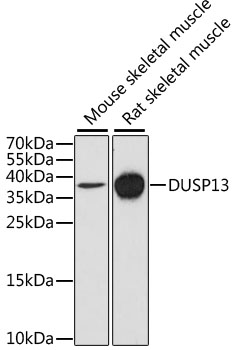Cell Biology Antibodies 10
Anti-DUSP13 Antibody (CAB6464)
- SKU:
- CAB6464
- Product Type:
- Antibody
- Reactivity:
- Mouse
- Reactivity:
- Rat
- Host Species:
- Rabbit
- Isotype:
- IgG
- Antibody Type:
- Polyclonal Antibody
- Research Area:
- Cell Biology
Description
| Antibody Name: | Anti-DUSP13 Antibody |
| Antibody SKU: | CAB6464 |
| Antibody Size: | 20uL, 50uL, 100uL |
| Application: | WB IHC |
| Reactivity: | Mouse, Rat |
| Host Species: | Rabbit |
| Immunogen: | Recombinant fusion protein containing a sequence corresponding to amino acids 1-198 of human DUSP13 (NP_057448.3). |
| Application: | WB IHC |
| Recommended Dilution: | WB 1:500 - 1:2000 IHC 1:50 - 1:200 |
| Reactivity: | Mouse, Rat |
| Positive Samples: | Mouse skeletal muscle, Rat skeletal muscle |
| Immunogen: | Recombinant fusion protein containing a sequence corresponding to amino acids 1-198 of human DUSP13 (NP_057448.3). |
| Purification Method: | Affinity purification |
| Storage Buffer: | Store at -20'C. Avoid freeze / thaw cycles. Buffer: PBS with 0.02% sodium azide, 50% glycerol, pH7.3. |
| Isotype: | IgG |
| Sequence: | MDSL QKQD LRRP KIHG AVQA SPYQ PPTL ASLQ RLLW VRQA ATLN HIDE VWPS LFLG DAYA ARDK SKLI QLGI THVV NAAA GKFQ VDTG AKFY RGMS LEYY GIEA DDNP FFDL SVYF LPVA RYIR AALS VPQG RVLV HCAM GVSR SATL VLAF LMIC ENMT LVEA IQTV QAHR NICP NSGF LRQL QVLD NRLG RETG RF |
| Gene ID: | 51207 |
| Uniprot: | Q6B8I1/Q9UII6 |
| Cellular Location: | Cytoplasm |
| Calculated MW: | 6kDa/7kDa/9kDa/17kDa/20kDa/22kDa/27kDa |
| Observed MW: | 36kDa |
| Synonyms: | DUSP13, BEDP, DUSP13A, DUSP13B, MDSP, SKRP4, TMDP |
| Background: | Members of the protein-tyrosine phosphatase superfamily cooperate with protein kinases to regulate cell proliferation and differentiation. This superfamily is separated into two families based on the substrate that is dephosphorylated. One family, the dual specificity phosphatases (DSPs) acts on both phosphotyrosine and phosphoserine/threonine residues. This gene encodes different but related DSP proteins through the use of non-overlapping open reading frames, alternate splicing, and presumed different transcription promoters. Expression of the distinct proteins from this gene has been found to be tissue specific and the proteins may be involved in postnatal development of specific tissues. A protein encoded by the upstream ORF was found in skeletal muscle, whereas the encoded protein from the downstream ORF was found only in testis. In mouse, a similar pattern of expression was found. Multiple alternatively spliced transcript variants were described, but the full-length sequence of only some were determined. |
| UniProt Protein Function: | DUSP13 iso5: May be involved in the regulation of meiosis and/or differentiation of testicular germ cells during spermatogenesis. Exhibits intrinsic phosphatase activity towards both phospho- seryl/threonyl and -tyrosyl residues of myelin basic protein, with similar specific activities in vitro. Belongs to the protein-tyrosine phosphatase family. Non-receptor class dual specificity subfamily. 5 isoforms of the human protein are produced by alternative promoter. |
| UniProt Protein Details: | Protein type:EC 3.1.3.16; Cell cycle regulation; Motility/polarity/chemotaxis; EC 3.1.3.48; Protein phosphatase, dual-specificity Chromosomal Location of Human Ortholog: 10q22.2 Molecular Function:protein binding Biological Process: meiosis; protein amino acid dephosphorylation; spermatogenesis |
| NCBI Summary: | Members of the protein-tyrosine phosphatase superfamily cooperate with protein kinases to regulate cell proliferation and differentiation. This superfamily is separated into two families based on the substrate that is dephosphorylated. One family, the dual specificity phosphatases (DSPs) acts on both phosphotyrosine and phosphoserine/threonine residues. This gene encodes different but related DSP proteins through the use of non-overlapping open reading frames, alternate splicing, and presumed different transcription promoters. Expression of the distinct proteins from this gene has been found to be tissue specific and the proteins may be involved in postnatal development of specific tissues. A protein encoded by the upstream ORF was found in skeletal muscle, whereas the encoded protein from the downstream ORF was found only in testis. In mouse, a similar pattern of expression was found. Multiple alternatively spliced transcript variants were described, but the full-length sequence of only some were determined. [provided by RefSeq, Jul 2008] |
| UniProt Code: | Q6B8I1 |
| NCBI GenInfo Identifier: | 74748394 |
| NCBI Gene ID: | 51207 |
| NCBI Accession: | Q6B8I1.1 |
| UniProt Secondary Accession: | Q6B8I1,Q96J67, |
| UniProt Related Accession: | Q6B8I1,Q9UII6 |
| Molecular Weight: | 17,283 Da |
| NCBI Full Name: | Dual specificity protein phosphatase 13 isoform A |
| NCBI Synonym Full Names: | dual specificity phosphatase 13 |
| NCBI Official Symbol: | DUSP13 |
| NCBI Official Synonym Symbols: | BEDP; MDSP; TMDP; SKRP4; DUSP13A; DUSP13B |
| NCBI Protein Information: | dual specificity protein phosphatase 13 |
| UniProt Protein Name: | Dual specificity protein phosphatase 13 isoform A |
| UniProt Synonym Protein Names: | Branching-enzyme interacting DSP; Muscle-restricted DSP; MDSP |
| Protein Family: | Dual specificity protein phosphatase |
| UniProt Gene Name: | DUSP13 |
| UniProt Entry Name: | DS13A_HUMAN |
View AllClose







